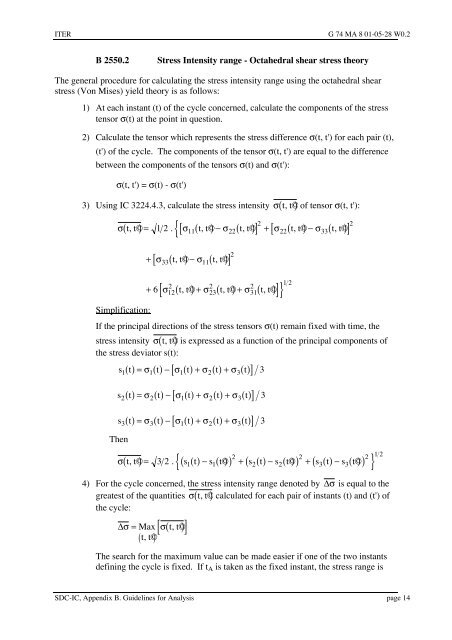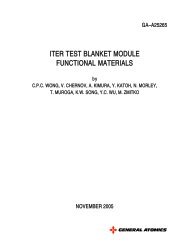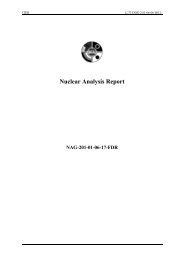iter structural design criteria for in-vessel components (sdc-ic)
iter structural design criteria for in-vessel components (sdc-ic)
iter structural design criteria for in-vessel components (sdc-ic)
Create successful ePaper yourself
Turn your PDF publications into a flip-book with our unique Google optimized e-Paper software.
ITER G 74 MA 8 01-05-28 W0.2<br />
BÊ2550.2 Stress Intensity range - Octahedral shear stress theory<br />
The general procedure <strong>for</strong> calculat<strong>in</strong>g the stress <strong>in</strong>tensity range us<strong>in</strong>g the octahedral shear<br />
stress (Von Mises) yield theory is as follows:<br />
1) At each <strong>in</strong>stant (t) of the cycle concerned, calculate the <strong>components</strong> of the stress<br />
tensor s(t) at the po<strong>in</strong>t <strong>in</strong> question.<br />
2) Calculate the tensor wh<strong>ic</strong>h represents the stress difference s(t, t') <strong>for</strong> each pair (t),<br />
(t') of the cycle. The <strong>components</strong> of the tensor s(t, t') are equal to the difference<br />
between the <strong>components</strong> of the tensors s(t) and s(t'):<br />
s(t, t') = s(t) - s(t')<br />
3) Us<strong>in</strong>g ICÊ3224.4.3, calculate the stress <strong>in</strong>tensity s( tt , © ) of tensor s(t, t'):<br />
{<br />
2<br />
[ 11 22 ] + [ 22 ( ) - 33(<br />
) ]<br />
( ) = ( ) - ( )<br />
s tt ,© 12.<br />
s tt ,© s tt ,© s tt ,© s tt ,©<br />
Simplif<strong>ic</strong>ation:<br />
[ s33 tt ,© s11<br />
tt ,© ]<br />
+ ( ) - ( )<br />
6 [ s12 tt ,© s tt ,© s tt ,© ]}<br />
2<br />
2<br />
23 31<br />
2<br />
+ ( ) + ( ) + ( )<br />
2<br />
If the pr<strong>in</strong>cipal directions of the stress tensors s(t) rema<strong>in</strong> fixed with time, the<br />
stress <strong>in</strong>tensity s tt , ©<br />
the stress deviator s(t):<br />
s t s t s t s t s t 3<br />
( ) is expressed as a function of the pr<strong>in</strong>cipal <strong>components</strong> of<br />
[ ]<br />
( ) = ( ) - ( ) + ( ) + ( )<br />
1 1 1 2 3<br />
[ ]<br />
( ) = ( ) - ( ) + ( ) + ( )<br />
s t s t s t s t s t<br />
2 2 1 2 3<br />
[ ]<br />
( ) = ( ) - ( ) + ( ) + ( )<br />
s t s t s t s t s t<br />
Then<br />
3 3 1 2 3<br />
2<br />
2<br />
( ) = ( ( ) - ( ) ) + ( ( ) - ( ) ) + ( ( ) - ( ) )<br />
s t,© t . s t s t© s t s t© s t s t©<br />
SDC-IC, Appendix B. Guidel<strong>in</strong>es <strong>for</strong> Analysis page 14<br />
3<br />
3<br />
{ 2 2<br />
3 3 }<br />
32 1 1<br />
12<br />
2<br />
2 12<br />
4) For the cycle concerned, the stress <strong>in</strong>tensity range denoted by Ds is equal to the<br />
greatest of the quantities s( tt , © ) calculated <strong>for</strong> each pair of <strong>in</strong>stants (t) and (t') of<br />
the cycle:<br />
Ds Max<br />
tt ,©<br />
s<br />
[ ]<br />
= ( tt ,© )<br />
( )<br />
The search <strong>for</strong> the maximum value can be made easier if one of the two <strong>in</strong>stants<br />
def<strong>in</strong><strong>in</strong>g the cycle is fixed. If tA is taken as the fixed <strong>in</strong>stant, the stress range is




